A part of Eastern Africa, the territory of what is now Kenya has seen human habitation since the beginning of the Lower Paleolithic. The Bantu expansion from a West African centre of dispersal reached the area by the 1st millennium AD. With the borders of the modern state at the crossroads of the Bantu, Nilo-Saharan and Afro-Asiatic ethno-linguistic areas of Africa, Kenya is a truly multi-ethnic state.

Kenya's economy is market-based with a few state-owned infrastructure enterprises and maintains a liberalised external trade system. The country is generally perceived as Eastern Africa's hub for Financial, Communication and Transportation services. Major industries include: agriculture, forestry and fishing, mining and minerals, industrial manufacturing, energy, tourism and financial services. As of 2019 estimates, Kenya had a GDP of $98.264 billion making it the 65th largest economy in the world. Per capita GDP was estimated at $1,991.
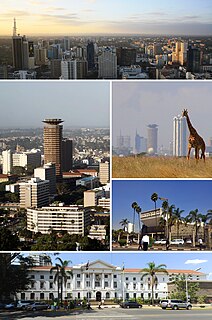
Nairobi is the capital and the largest city of Kenya. The name comes from the Maasai phrase Enkare Nairobi, which translates to "cool water", a reference to the Nairobi River which flows through the city. The city proper had a population of 3,138,369 in the 2009 census, while the metropolitan area has a population of 6,547,547. The city is popularly referred to as the Green City in the Sun.
Kenya Airways Ltd., more commonly known as Kenya Airways, is the flag carrier airline of Kenya. The company was founded in 1977, after the dissolution of East African Airways. Their head office is located in Embakasi, Nairobi, with its hub at Jomo Kenyatta International Airport.

The Mau Mau Uprising (1952–1960), also known as the Mau Mau Rebellion, the Kenya Emergency, and the Mau Mau Revolt, was a war in the British Kenya Colony (1920–1963) between the Kenya Land and Freedom Army (KLFA), also known as Mau Mau, and the British colonists.
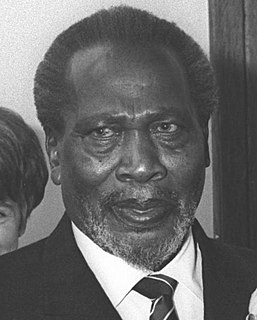
Jomo Kenyatta was a Kenyan anti-colonial activist and politician who governed Kenya as its Prime Minister from 1963 to 1964 and then as its first President from 1964 to his death in 1978. He was the country's first indigenous head of government and played a significant role in the transformation of Kenya from a colony of the British Empire into an independent republic. Ideologically an African nationalist and conservative, he led the Kenya African National Union (KANU) party from 1961 until his death.
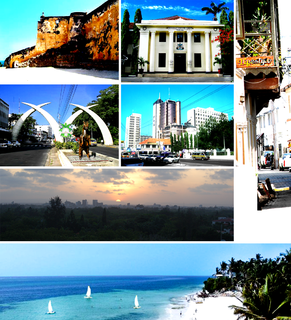
Mombasa is a coastal city of Kenya along the Indian Ocean. It is the country's oldest and second-largest city, with an estimated population of about 1.5 million people in 2017. Its metropolitan region is the second largest in the country and has a population of approximately 3 million people. Administratively, Mombasa is the county seat of Mombasa County.
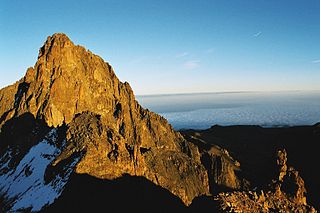
Mount Kenya is the highest mountain in Kenya and the second-highest in Africa, after Kilimanjaro. The highest peaks of the mountain are Batian, Nelion and Point Lenana. Mount Kenya is located in the former Eastern and central provinces of Kenya, now Meru, Embu, Laikipia, Kirinyaga, Nyeri and Tharaka Nithi counties, about 16.5 kilometres (10.3 mi) south of the equator, around 150 kilometres (93 mi) north-northeast of the capital Nairobi. Mount Kenya is the source of the name of the Republic of Kenya.

The President of the Republic of Kenya is the head of state and head of government of Kenya. The president leads the executive branch of the Government of Kenya and is the commander-in-chief of the Kenya Defence Forces. The official residence of the president is at State House, Nairobi. The wife of the President is referred to as the First Lady of Kenya.
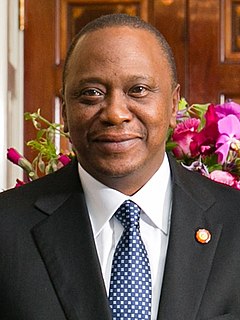
Uhuru Muigai Kenyatta is a Kenyan politician and businessman who is the fourth and current President of the Republic of Kenya. He served as the Member of Parliament (MP) for Gatundu South from 2002 to 2013. Currently the party leader and a member of the Jubilee Party of Kenya, he was previously involved with The National Alliance and before that the Kenya African National Union.

The Kenya national cricket team represents the Republic of Kenya in international cricket. Kenya is an associate member of the International Cricket Council (ICC) which has Twenty20 International (T20I) status after the ICC granted T20I status to all of their members.

The Kenya national football team represents Kenya in international football. It is controlled by the Football Kenya Federation, the governing body of football in Kenya, and competes as a member of the Confederation of African Football (CAF) and the Council for East and Central Africa Football Associations (CECAFA), a sub-confederation of CAF that has jurisdiction in East and Central Africa. The team is colloquially known as the Harambee Stars and plays its home games primarily at the Nyayo National Stadium in the country's capital, Nairobi. The team has never qualified for a FIFA World Cup finals.

The East African Community (EAC) is an intergovernmental organization composed of six countries in the African Great Lakes region in eastern Africa: Burundi, Kenya, Rwanda, South Sudan, Tanzania, and Uganda. Paul Kagame, the president of Rwanda, is the EAC's chairman. The organisation was founded in 1967, collapsed in 1977, and was revived on 7 July 2000. In 2008, after negotiations with the Southern African Development Community (SADC) and the Common Market for Eastern and Southern Africa (COMESA), the EAC agreed to an expanded free trade area including the member states of all three organizations. The EAC is an integral part of the African Economic Community.
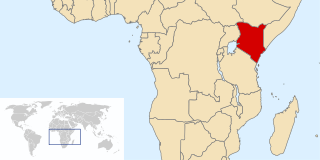
The culture of Kenya consists of multiple trends. Kenya has no single prominent culture that identifies it. It instead consists of various cultures practiced by the country's different communities.

The Sultanate of Zanzibar, also known as the Zanzibar Sultanate, comprised the territories over which the Sultan of Zanzibar was the sovereign. Those territories varied over time, and at one point included all of what is now Kenya as well as the Zanzibar Archipelago of the Swahili Coast. Later, the kingdom's realm included only a ten mile wide coastal strip of Kenya and Zanzibar. Under an agreement concluded on 8 October 1963, the Sultan relinquished sovereignty over his remaining territory in Kenya. On 12 January 1964, Sultan Jamshid bin Abdullah was deposed and lost sovereignty over the last of his dominions, Zanzibar.

The Colony and Protectorate of Kenya was part of the British Empire in Africa from 1920 until 1963. It was established when the former East Africa Protectorate was transformed into a British Crown colony in 1920. Technically, the 'Colony of Kenya' referred to the interior lands, while a 16 km (10 mi) coastal strip was the 'Protectorate of Kenya' but the two were controlled as a single administrative unit. The colony came to an end in 1963 when a black majority government was elected for the first time and eventually declared independence as Kenya.

The counties of Kenya are geographical units envisioned by the 2010 Constitution of Kenya as the units of devolved government. The powers are provided in Articles 191 and 192, and in the fourth schedule of the Constitution of Kenya and the County Governments Act of 2012. The counties are also single member constituencies for the election of members of parliament to the Senate of Kenya and special women members of parliament to the National Assembly of Kenya. As of 2013 general elections, there are 47 counties whose size and boundaries are based on the 47 legally recognised Districts of Kenya. Following the re-organisation of Kenya's national administration, counties were integrated into a new national administration with the national government posting county commissioners to represent it at the counties.

Operation Linda Nchi was the Kenya Defence Forces operation - in many ways an invasion - covering the entry of Kenyan military forces into southern Somalia beginning in 2011. The Kenyan government declared the operation completed in March 2012, but its forces joined AMISOM in Somalia and are not expected to leave before 2020.
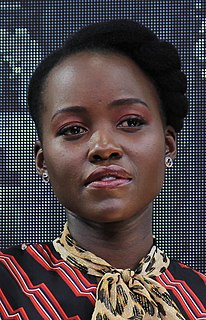
Lupita Amondi Nyong'o is a Kenyan-Mexican actress. The daughter of Kenyan politician Peter Anyang' Nyong'o, she was born in Mexico City, where her father was teaching, and was raised in Kenya from the age of one. She attended college in the United States, earning a bachelor's degree in film and theater studies from Hampshire College.


















